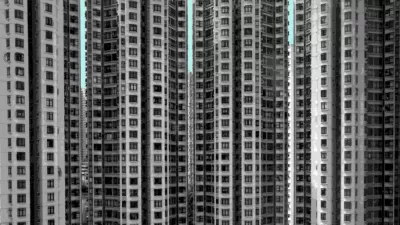Headlined by vertical (and horizontal) sprawl in China, India, and elsewhere, the global building boom requires vast quantities of concrete and asphalt. And to get those materials, sand must be taken from the environment.

A key ingredient in concrete and asphalt, sand needs to be mined, usually by dredging from riverbanks, lakeshores, and the like. As demand rises, unsustainable extraction can impact ecosystems, natural features, and even human infrastructure.
Vince Beiser writes, "Just about every apartment block, skyscraper, office tower and shopping mall that gets built anywhere from Beijing to Lagos is made with concrete, which is essentially just sand and gravel glued together with cement."
In China, Beiser chronicles the ongoing woes of Poyang Lake, a key regional site for sand mining. "Different types of sand mining inflict different types of damage. Dredging from river beds destroys the habitat of bottom-dwelling creatures and organisms. The churned-up sediment clouds the water, suffocating fish and blocking the sunlight that sustains underwater vegetation."
Local sand mining fueled our own urban boom. "For most of the 20th century there were many such sand mines along the California coast, but in the late 1980s the federal government shut them down due to the erosion being suffered by the Golden State's famous beaches." In addition, sand mining can compromise the integrity of infrastructure: "a 1998 study found that each tonne of aggregate mined from a California river caused $3 in infrastructure damage – costs that are borne by taxpayers."
FULL STORY: Sand mining: the global environmental crisis you’ve probably never heard of

Alabama: Trump Terminates Settlements for Black Communities Harmed By Raw Sewage
Trump deemed the landmark civil rights agreement “illegal DEI and environmental justice policy.”

Planetizen Federal Action Tracker
A weekly monitor of how Trump’s orders and actions are impacting planners and planning in America.

The 120 Year Old Tiny Home Villages That Sheltered San Francisco’s Earthquake Refugees
More than a century ago, San Francisco mobilized to house thousands of residents displaced by the 1906 earthquake. Could their strategy offer a model for the present?

Ken Jennings Launches Transit Web Series
The Jeopardy champ wants you to ride public transit.

BLM To Rescind Public Lands Rule
The change will downgrade conservation, once again putting federal land at risk for mining and other extractive uses.

Indy Neighborhood Group Builds Temporary Multi-Use Path
Community members, aided in part by funding from the city, repurposed a vehicle lane to create a protected bike and pedestrian path for the summer season.
Urban Design for Planners 1: Software Tools
This six-course series explores essential urban design concepts using open source software and equips planners with the tools they need to participate fully in the urban design process.
Planning for Universal Design
Learn the tools for implementing Universal Design in planning regulations.
Clanton & Associates, Inc.
Jessamine County Fiscal Court
Institute for Housing and Urban Development Studies (IHS)
City of Grandview
Harvard GSD Executive Education
Toledo-Lucas County Plan Commissions
Salt Lake City
NYU Wagner Graduate School of Public Service




























